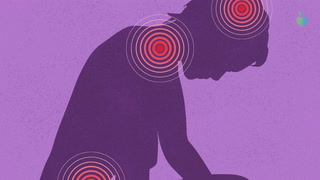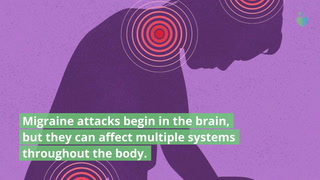Migraine is not just a headache.
Its a neurological disease that can be disabling.
An estimated one billion people worldwide, and 39 million Americans, have migraine.

What Is Migraine?
The frequency of attacks varies from person to person.
Some people have attacks several times a month, while others have them much less frequently.

Migraine can cause any or all of these symptoms in a person with the condition.
On the other hand, some migraine attacks can last even longer than 72 hours.
There are still gaps in doctors understanding of what causes migraine.
And some of these subtypes have sub-subtypes of their own.

A person can have more than one throw in of migraine simultaneously, as well as other types ofheadaches.
Episodic migraine is defined as fewer than 15 days of migrainous symptoms per month.
An estimated 144 million people worldwide and three to seven million Americans have chronic migraine.

It can be essential if you want to participate in clinical trials.
Alternatively, a person may feel elated and even euphoric after the headache phase of a migraine has passed.
In some cases, aura symptoms occur with no headache accompanying or following them.

Hemiplegic Migraine
Hemiplegic migraine comes in two forms: familial hemiplegic migraine and sporadic hemiplegic migraine.
Both are characterized by aura, fever, and hemiplegia (paralysis on one side of the body).
Both are relatively rare.

Between attacks, which occur on a regular cycle, the person has no symptoms of nausea or vomiting.
Abdominal MigraineThis pop in of episodic migraine is diagnosed mostly in children.
Symptoms include abdominal pain, nausea, and vomiting.

In general, though, migraine attacks are very painful and can interfere with your daily life.
Headache StagePain comes with the headache phase, which can last several hours and up to three days.
The throbbing pain may start on one side of the head and move to include both sides.

You may have trouble concentrating and may still be hypersensitive to certain stimuli.
Causes and Risk Factors of Migraine
The exact cause of migraine remains unknown.
Research suggests that genetic and environmental factors may play a role.

Studieshave linked changes in the brain stem and the trigeminal nerve, which mediates pain, to migraine.
Chemical imbalances in the brain may also be involved.Depression and anxietyhave long been associated with migraine.
Researchers have identified several key risk factors for developing migraine, including the following.

Is Migraine Heredity?
How Does Age Affect Risk?
What About Gender?

In adulthood, women are much more likely than men to experience migraine.
It seems that hormonal changes, specifically involvingestrogen, play a role.
The frequency, severity, and duration of migraine may change duringpregnancyormenopause.

The above observations suggest that hormonal fluctuations of estrogen and progesterone are factors in some women with migraine.
Learn More About Migraine Causes and Risk Factors
Migraine Triggers
Migraine triggers dont directly cause migraine.
But they can contribute to the onset of a migraine attack.

Often you need several triggers to lead to a migraine attack, not just one.
Other weather-related migraine triggers include heat, humidity, wind, and reduced light exposure.
Overusing pain medications can also lead to headache.

Dehydration
According to theAMF, about one-third of people citedehydrationas a migraine trigger.
check that youre drinking enough water throughout the day to avoid dehydration.
Foods and Food Additives
Certain foods and beverages, particularly alcoholic beverages, can be triggers.

The flavor enhancer monosodium glutamate can also be a trigger, as cancaffeine.
Foods containing the amino acid tyramine have been associated with migraine onset.
Examples include aged cheese, smoked fish, chicken livers, figs, certain beans, and red wine.

Research has also suggested that the artificial sweeteners aspartame and sucralose can be triggers.
Missing or skipping meals can trigger attacks, too.
Interestingly, relaxing after a stressful day or event can also lead to a migraine attack.

According to theAMF, this is sometimes called a letdown headache.
How Is Migraine Diagnosed?
Theres no single test that can lead to a diagnosis of migraine.

Your healthcare provider may order certain blood tests and imaging tests to rule out other causes of headache.
But having one pop in of primary headache disorder doesnt rule out having another.
In fact, many people have both migraine and tension-key in headache.

Prognosis of Migraine
Migraine has a highly variable long-term prognosis.
Still others have long periods of remission, during which they have no migraine attacks.
Only six people in the study had developed chronic migraine over the study period.
The researchers were unsure whether these changes reflected how migraine evolves naturally or better migraine management among study participants.
In addition, antinausea medications can help relieve symptoms for those who experience nausea and vomiting with migraine.
Unlike triptans, gepants can be used by people with cardiovascular risk factors or stroke risk.
The one form of ergot that is still widely used is dihydroergotamine (D.H.E.
Metoclopramide and chlorpromazine are available in tablet and liquid form, or by injection.
Metoclopramide is also available as a nasal spray.
Prochlorperzine is given by tablet, suppository, or injection.
Two exceptions are the CGRP antibodies and theCGRP receptor antagonists, or gepants.
Preventive treatment is usually recommended for people who have very severe or frequent, long-lasting migraine attacks.
Some people with migraine may require both preventive treatments and acute treatments to control their attacks.
These drugs are injected once a month or infused intravenously once every three months.
Similar to gepants, CGRP antibodies work by blocking the action of CGRP.
Theyve been shown to reduce migraine days in both episodic and chronic migraine.
(Its not FDA-approved for episodic migraine.)
Beta-BlockersBeta-blockers are drugs that lower blood pressure.
When taken daily, they can help prevent migraine attacks in some people.
AntidepressantsAs their name implies, antidepressants are taken most often to treat depression.
But they can sometimes prevent migraine attacks as well.
These drugs are all taken as pills or capsules.
Antiseizure DrugsCertain anticonvulsant, or antiseizure, drugs are considered first-line treatment for preventing migraine,according to StatPearls.
Those include valproate, valproic acid (Depakene), and topiramate (Topamax).
An implanted equipment also targets the occipital nerve.
Eating Regular MealsSkipping meals is a common migraine trigger.
Staying HydratedDrinking adequate liquid throughout the day is as important at eating regularly.
What works best depends on the individual.
Practicing yoga or meditation may reduce stress for some.
And working with apsychotherapiston issues that contribute to stress can also help you reduce your stress levels.
The trick is to start with low-impact, low-intensity movement and build up gradually.
Many organizations provide educational materials and can assist you in finding doctors specializing in migraine care.
There are also online communities that offer support as well as practical advice and tips.
Migraine at Work is a project of theWorld Health Education Foundation.
The INvisible Project
The INvisible Project, the flagship program of theU.S.
Pain Foundation, produces online magazines with real stories and photographs of people coping with chronic pain.
Migraine Again
Migraine Again calls itself a lifestyle website for people with migraine and the people who love them.
The app also analyzes your data to determine the pop in of headache youre having.
The technology helps patients identify likely triggers associated with their migraine and prevent future headaches.
Finding patterns in migraine can help with treatment.
A key helps pinpoint types of triggers and evaluate migraine severity.
He is based in New York City.